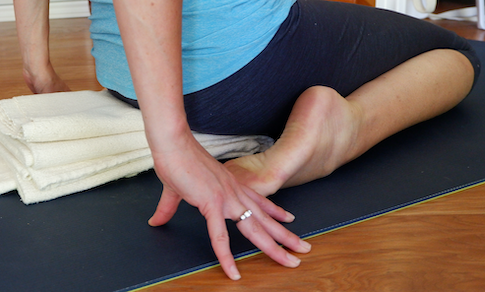Bent Moment - feet & ankles
- bentmatyoga
- Jun 3, 2021
- 4 min read
Updated: Oct 11, 2022

Tight or weak ankles, flat feet (collapsed arches) and knees benefit from this practice.
There are three main arches within the foot; the inner (medial) arch that most people associate with a foot, the outer (lateral) arch which runs along the small toe side of the foot and the transverse arch which runs along the base of the toe pads. Learn how to strengthen each of these arches, to open and strengthen the ankles.
Virasana (hero's pose):
kneel on a firm surface*, knees close together, ankles slightly wider than your hips
sit back between your ankles, moving the calf muscles outward with your hands: check in on your way down for mobility (see below under 'assistance' if you are having difficulties)
look at your knees, the thighs should be no wider than parallel with each other
look at the outside line of the lower leg: adjust the ankle so there is a straight line from the outside of the knee all the way to the small toe: if the ankles are bowing out, bring them in against the outside of the hip/if they are bowing in, move them away from the outside hip wedging something in to support the ankle if necessary
extend the toes back, spread the toes, press down on the front of the foot and shin
build up the time you spend in this pose
when it is time to come out it is important to open the backs of the knees, one way is to lean forward until you are on your hands and knees. Extend one leg behind you reaching back with the heel, toes tucked under, until the leg is straight, hold for a bit, return that knee and then extend the opposite leg.
Assistance:
Can't quite bring the buttocks down to the floor - check in how close you are and then select a few firm items that are similar to that distance: a folded firm blanket or towel, hard cover books, yoga block, solid cooking pot, a stool (narrow enough to allow correct foot placement).
Causes pain in the front of the ankles - reduce the front extension. Use a firm folded blanket/towel large enough to support the knee, shin and front of the ankle of both legs. Use two or even a couch cushion, if necessary, but don't use so much support that you are no longer stretching the front of the foot to your ability.
Causes pain in the knees - create space in the back of the knees. Pain in the knees is not a good pain, don't just sit this one through - make adjustments. If the pain is from kneeling on a hard surface, try a folded blanket under the lower leg as mentioned above. If the pain is within the knee - create space with an object such as a yoga belt (or housecoat belt), or folded blanket like what you see under the legs in the pictures. Bring the object in tight behind both knees as you sit back. If this does not alleviate the pain within a few seconds you will need more height under the buttocks.
Just not going to happen - sit on the front edge of a stable chair like a dining room chair, hold on to the chair seat and tuck one foot under, resting the tops of the toes against the floor as you extend the foot back under the chair seat. Return and then do the same with the opposite foot. Build up mobility at this height and perhaps over time you can try a lower height like a stool.
Need more assistance - this is one of those poses that can really benefit from a teacher's perspective. If this one just isn't working and you want to practice it, find yourself a yoga teacher that understands alignment to assist you. I teach virtually, feel free to attend one of my classes or privates and we'll figure out how to make it work for you together.
How it helps:
Opening up the joints - the ankle is another area of the body we don't often use to its full capacity. Keep the front of the ankles supple by lengthening and opening. Ensure you are keeping the ankle from bowing in or out to gain the greatest benefit.
Arches - building up a muscle requires you to use it by engaging it. There are adjustments to be made in all yoga poses and general life that will benefit and tone the muscles of the feet. This particular pose is a 'quick' method to teach the muscles how to move.
Knees - learning how to correctly align the knees helps to strengthen the knees. Mobility without pain, if your knees are your weakest link, approach with caution, as mentioned above, there should be no pain in the knee.
* a firm surface doesn't have to be a hard tile floor, you can create some cushioning with carpet, a yoga mat or blanket as necessary. Practicing on too soft of a surface, like a bed, will not give you enough support to truly benefit from the pose.
Creating a healthier body can be overwhelming...
Taking one moment at a time to relieve an ache or pain can make a goal more achievable, and worth your time.
Wishing you great health, Tanya

Tanya is a certified Iyengar Yoga teacher based out of Abbotsford, BC Canada. She has been teaching since 2015, strictly online since March 2020. Tanya volunteers her time as a board member for the BKS Iyengar Yoga Association Vancouver. Her greatest joy is being able to help discover movement.









Comments